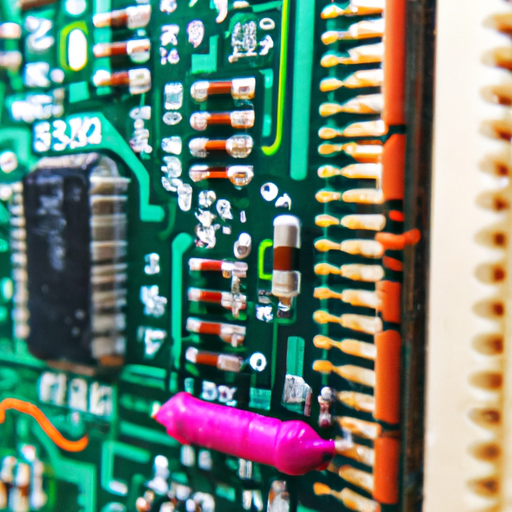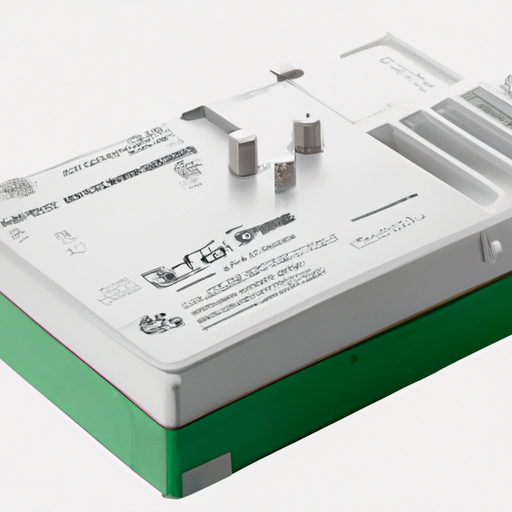
Resistors are common electronic components used to limit current, regulate voltage, and divide circuits. In the electronics industry, resistors are essential components widely used in various electronic devices and circuits. As a manufacturer of resistors, resistor factories have many important patents related to resistors, which are significant for protecting the company's trade secrets, enhancing product competitiveness, and driving industry development.Firstly, resistor factory patents involve the structural design and manufacturing processes of resistors. The structural design of resistors has a significant impact on their performance and stability, so resistor factories apply for related patents when designing resistors. For example, some resistor factories may have patents related to resistor structure, including material selection, dimension design, connection methods, and other technologies. These patents can protect the company's trade secrets, prevent others from copying, and enhance the uniqueness and competitiveness of the products.Secondly, resistor factory patents also involve the manufacturing processes and production equipment of resistors. The manufacturing process of resistors has a crucial influence on product quality and cost, so resistor factories continuously improve processes and apply for related patents during production. For example, some resistor factories may have patents related to resistor manufacturing processes, including equipment design, production process optimization, quality control methods, and other technologies. These patents can help companies improve production efficiency, reduce costs, protect production technology, and prevent imitation by others.Additionally, resistor factory patents may also involve the application areas and technological innovations of resistors. With the development of technology, resistors are increasingly used in various fields such as communication, automotive, medical industries, etc. Resistor factories may conduct research and development for different application areas and apply for related patents. For example, some resistor factories may have patents related to resistor technology in specific application areas, including performance optimization in specific environments, coordination with other components, and other technologies. These patents can help companies gain a competitive advantage in specific fields and expand market share.In conclusion, the industry-related important patents held by resistor factories involve technologies related to resistor structural design, manufacturing processes, application areas, etc. These patents are crucial for protecting the company's trade secrets, enhancing product competitiveness, and driving industry development. Resistor factories need to consider market demands and technological trends when applying for patents, continuously innovate and improve to maintain competitiveness and leadership. Additionally, resistor factories need to strengthen patent management and maintenance to ensure the effectiveness and protection scope of patents, providing strong support for the company's sustainable development.

Neutral point resistor is a protective device used in power systems, whose main function is to introduce a neutral point grounding resistor in the system to ensure that the current in the system can flow normally and prevent equipment damage or threats to personal safety caused by high or low voltage. The product features of neutral point resistors mainly include the following aspects:1. High reliability: Neutral point resistors are made of high-quality materials and advanced production processes, with good high temperature resistance, corrosion resistance, and seismic resistance, and can operate stably in harsh environmental conditions to ensure the safe and stable operation of the power system.2. High precision: Neutral point resistors are designed and manufactured in strict accordance with international standards, with high-precision resistance values and stable performance, which can accurately control the current and voltage in the system to ensure the normal operation of the system.3. Good heat dissipation performance: Neutral point resistors use high-quality heat dissipation materials and designs, with good heat dissipation performance, which can effectively dissipate the generated heat and avoid equipment damage caused by overheating.4. Safe and reliable: Neutral point resistors have good safety performance, effectively preventing current overload and short circuit faults in the power system, ensuring the safety of equipment and personnel.5. Easy to install and maintain: Neutral point resistors have a simple structure, convenient installation, low maintenance costs, and can be quickly replaced and repaired, reducing system downtime, improving system reliability and stability.In summary, as an important protective device in power systems, neutral point resistors have product features such as high reliability, high precision, good heat dissipation performance, safety and reliability, and easy installation and maintenance. They can effectively protect the safe and stable operation of power systems and are indispensable important equipment in power systems.

A lifting resistor is an important device used to measure and monitor the load of lifting equipment. It determines the weight of the load by measuring the resistance value, ensuring the safe operation of the lifting equipment. With the continuous development of technology, the functionality and performance of lifting resistors are constantly improving, providing users with more accurate and reliable load monitoring services.The latest lifting resistors are designed and manufactured using the most advanced technology and materials, with higher accuracy and stability. They typically use advanced sensors and electronic components to monitor changes in the load in real time and provide timely feedback to operators. Additionally, these lifting resistors have more intelligent functions, allowing them to be connected to computers or monitoring systems for remote monitoring and data transmission.When choosing the latest lifting resistor, in addition to focusing on its performance and functionality, price is also an important consideration. According to market research, the price of the latest lifting resistors on the market currently ranges from 2000 to 5000 yuan, depending on factors such as brand, model, and performance. Generally, lifting resistors from well-known brands are relatively more expensive, but their quality and performance are also more reliable.When purchasing the latest lifting resistor, it is recommended that users first clarify their needs and budget, and then choose a brand and model that meets their requirements. Additionally, it is important to purchase from legitimate channels to ensure product quality and after-sales service. Furthermore, comparing prices of different brands and models can help choose a product with good value for money.In conclusion, the latest lifting resistors have significant applications in the field of lifting equipment monitoring, improving work efficiency and safety. When choosing and purchasing, users should consider factors such as product performance, price, and after-sales service, and select a product that suits their needs. We hope this article has been helpful to you, thank you for reading!

The car resistor is an electronic component used to regulate current, playing a very important role in the car circuit. Car resistors are usually made of conductive materials with a certain resistance value, which can limit the flow of current to protect other components in the circuit from overload damage. Car resistors are widely used in various aspects of car ignition systems, lighting systems, cooling systems, etc.There are many types of car resistors, which can be divided into fixed resistors and variable resistors according to their uses and working principles. The resistance value of fixed resistors is fixed and is generally used for fixed current limiting and voltage dividing circuits. Variable resistors, on the other hand, have a resistance value that can be changed by adjusting the position or knob of the device, used to adjust the current in the circuit, such as adjusting the engine speed of the car, adjusting the brightness of the headlights, etc.In the car circuit, the main functions of car resistors are as follows:1. Current limiting: Various components in the car circuit have their own working current range. If the current is too large, it will cause overload damage to the components. Car resistors can protect other components in the circuit from damage by limiting the current.2. Voltage regulation: The voltage in the car circuit has an important impact on the working state of various components. Car resistors can change the voltage in the circuit by adjusting the resistance value, thereby regulating the voltage of the components.3. Voltage dividing: In some circuits that need to distribute voltage to different components, car resistors can play a role in voltage dividing, distributing voltage to different components to ensure their normal operation.4. Adjusting engine speed: In the car's ignition system, car resistors can control the current in the ignition system by adjusting the resistance value in the circuit, thereby adjusting the engine speed.In conclusion, car resistors are indispensable components in car circuits. They protect other components in the car circuit, regulate and control various systems of the car by limiting current, regulating voltage, dividing voltage, etc. Car resistors play an important role in ensuring the stability and safety of car circuits during normal operation.

Resistors are electronic components used to limit the flow of electric current. Their main function is to dissipate electrical energy and convert it into heat. Depending on their structure and materials, resistors can be divided into various types, each with specific uses and characteristics.Firstly, resistors can be classified into fixed resistors and variable resistors based on their structure. Fixed resistors have a constant resistance value and include carbon film resistors, metal film resistors, and metal oxide resistors. These resistors are commonly used in circuits to stabilize current and voltage. On the other hand, variable resistors have an adjustable resistance value and include potentiometers and variable resistors. Variable resistors are used to adjust current and voltage in circuits, thereby enhancing circuit performance.Secondly, resistors can be categorized into different types based on their materials, such as carbon film resistors, metal film resistors, and metal oxide resistors. Carbon film resistors have a resistance body made of carbon film, offering high stability and heat resistance, making them suitable for high-temperature environments. Metal film resistors have a resistance body made of metal film, providing high precision and stability, commonly used in precision instruments and meters. Metal oxide resistors have a resistance body made of metal oxide, offering high heat resistance and stability, suitable for high-temperature circuits.Furthermore, resistors can be classified into high-power resistors and low-power resistors based on their power rating. High-power resistors can withstand large power levels and are used in high-power circuits and high-temperature environments. Low-power resistors can handle lower power levels and are used in low-power circuits and precision instruments.In conclusion, resistors are essential electronic components that play a crucial role in limiting current, adjusting voltage, and dissipating electrical energy in circuits. With different structures, materials, and power ratings, resistors come in various types, each with specific uses and characteristics. When selecting resistors for practical applications, it is important to choose the appropriate type based on the specific requirements of the circuit to ensure proper operation and stable performance.

Resistors are common electronic components used for functions such as limiting current, regulating voltage, voltage division, and current division in circuits. Resistor circuit symbol products have many advantages, making them widely used in various electronic devices and circuits.Firstly, resistor circuit symbol products have stability and reliability. Resistors are passive components that do not require external power supply, so they do not cause problems in the circuit due to power supply failures. In addition, resistors have a simple working principle, stable structure, and are not easily affected by external environmental factors, thus ensuring high reliability.Secondly, resistor circuit symbol products have high accuracy and stability. The resistance value of a resistor can be precisely adjusted as needed to meet the requirements of different circuits. Moreover, the resistance value of a resistor remains basically unchanged within a certain range, and does not fluctuate significantly due to changes in temperature, humidity, and other external factors, ensuring circuit stability.Furthermore, resistor circuit symbol products have high voltage and heat resistance. Resistors are usually made of materials such as metal or carbon film, which have high voltage and heat resistance, allowing them to work normally under high voltage and temperature conditions without being easily damaged.Additionally, resistor circuit symbol products have small size and light weight. Resistors have relatively small size and weight, making it convenient to integrate them into various electronic devices and circuits, saving space and improving overall device performance.Lastly, resistor circuit symbol products have low cost. Resistors are common electronic components with low production costs and relatively cheap prices, allowing for mass production to reduce overall costs, making them widely used in various electronic devices and circuits.In conclusion, resistor circuit symbol products have advantages such as stability, reliability, accuracy, stability, voltage resistance, heat resistance, small size, light weight, and low cost, making them widely used in various electronic devices and circuits. In the future, with the continuous advancement of electronic technology and the expansion of application areas, resistor circuit symbol products will become more popular and widely used.

Sensitive resistors are electronic components used for measuring and controlling current, widely used in various electronic devices and systems. With the continuous development and progress of technology, the market for sensitive resistors is also growing and expanding. In order to better meet market demand, it is crucial to formulate reasonable market policies.Firstly, the market policy for sensitive resistors should focus on product quality. As an electronic component, the quality of sensitive resistors directly affects the performance and stability of the entire electronic device. Therefore, manufacturers should strictly control product quality to ensure that products meet international standards and industry requirements. At the same time, quality monitoring and testing of products should be strengthened to promptly identify and resolve quality issues, improving product reliability and stability.Secondly, the market policy for sensitive resistors should focus on technological innovation. With the continuous advancement of technology, the functional and performance requirements of electronic devices are also constantly increasing. To meet market demand, manufacturers should continuously innovate in technology, develop new materials and processes, and improve product performance and functionality. Additionally, collaboration with research institutions and universities should be strengthened to conduct joint technological research and development, promoting industry development and progress.Thirdly, the market policy for sensitive resistors should focus on marketing. Marketing is an important means for companies to promote products and expand markets. Manufacturers should develop reasonable marketing strategies based on market demand and competitive conditions to increase product visibility and reputation. Additionally, cooperation with distributors and agents should be strengthened to expand sales channels and explore new market opportunities.Lastly, the market policy for sensitive resistors should focus on after-sales service. After-sales service is an important part of establishing long-term cooperation between companies and customers. Manufacturers should establish a sound after-sales service system, promptly respond to customer needs and issues, and provide high-quality after-sales service. Furthermore, communication and feedback with customers should be enhanced to understand customer needs and opinions, continuously improve products and services, and enhance customer satisfaction and loyalty.In conclusion, the market policy for sensitive resistors should focus on product quality, technological innovation, marketing, and after-sales service to meet market demand, improve product competitiveness, and achieve sustainable development. Manufacturers should flexibly adjust market policies according to market conditions and competitive environment, continuously enhance the core competitiveness of enterprises, and win the trust and support of the market and customers.

Precision resistors are electronic components used to precisely control current and voltage, with advantages such as high accuracy, stability, and reliability. In modern electronic devices and instruments, precision resistors are widely used in various precision measurement, control, and calibration applications. Below, we will detail the advantages of precision resistor products.Firstly, precision resistors have high accuracy. The accuracy of precision resistors can typically reach 0.01% or even higher, meeting the requirements for high precision in current and voltage applications. In fields that require precision measurement and control, such as medical equipment, scientific instruments, and aerospace, the high accuracy of precision resistors ensures system stability and reliability.Secondly, precision resistors have good stability. During long-term use, precision resistors exhibit minimal changes in resistance, maintaining stable performance. This stability ensures that electronic devices and instruments can operate normally under different environmental conditions without affecting system performance due to resistance changes.Additionally, precision resistors have a low temperature coefficient. The temperature coefficient refers to the rate of resistance change at different temperatures, and precision resistors typically have a low temperature coefficient, maintaining stable performance under different temperature conditions. This characteristic makes precision resistors important in applications requiring precise temperature compensation.Furthermore, precision resistors have high voltage and current capabilities. Precision resistors are usually manufactured using high-quality materials and processes, able to withstand high voltages and currents, and are less susceptible to external interference and damage. This voltage and current capability provides precision resistors with good stability and reliability in high voltage and current applications.In summary, precision resistor products have advantages such as high accuracy, stability, low temperature coefficient, and high voltage and current capabilities, meeting the requirements for high precision in current and voltage applications. In modern electronic devices and instruments, the application range of precision resistors is expanding, providing crucial support for various precision measurement, control, and calibration tasks. With the continuous development of technology, we believe that the advantages of precision resistor products will be better utilized and applied.

Thick film resistors are a common electronic component widely used in various electronic devices. They have the advantages of small size, light weight, and low cost, making them an important component in the electronics industry. With the continuous development of technology, the thick film resistor industry is also growing, with increasing market demand.Currently, the development of the thick film resistor industry presents the following characteristics:Firstly, the market demand continues to grow. With the popularity and upgrading of electronic products, the demand for thick film resistors is also increasing. Especially with the development of new technologies such as the Internet of Things and artificial intelligence, the requirements for electronic components are becoming higher, bringing new development opportunities for the thick film resistor industry.Secondly, the technological level is constantly improving. With the continuous advancement of technology, the manufacturing process and technological level of thick film resistors are also constantly improving. Currently, domestic thick film resistor companies have made significant progress in material selection, process flow, product quality, etc., to meet the market's requirements for high performance and high reliability.Thirdly, the market competition is fierce. With the increase in market demand, competition in the thick film resistor industry is becoming increasingly fierce. Domestic and foreign manufacturers are increasing their research and development investment, improving product quality, reducing costs, to compete for market share. In this competitive environment, companies need to continuously enhance their own strength, strengthen technological innovation, improve product quality, in order to stand undefeated in the market.Lastly, the industry chain is constantly improving. With the development of the thick film resistor industry, the related industry chain is also constantly improving. From raw material supply to production manufacturing to sales channels, the entire industry chain is becoming more complete, providing strong support for the healthy development of the industry.In summary, the thick film resistor industry is currently in a stage of vigorous development, with continuous growth in market demand, constant improvement in technological level, fierce market competition, and continuous improvement in the industry chain. In the future, with the continuous advancement of technology and the continuous increase in market demand, the thick film resistor industry is expected to usher in a broader development space, bringing more business opportunities and opportunities. Enterprises should seize the opportunity, strengthen technological innovation, improve product quality, continuously enhance their competitiveness, and achieve sustainable development.

Resistor wiring diagram is a component used in circuits to adjust the resistance value, usually made of conductive materials with a specific resistance value. In a circuit, resistors play a role in limiting current, adjusting voltage, voltage division, current division, etc., and are one of the commonly used components in electronic circuits.A resistor wiring diagram refers to the illustrated explanation of how a resistor is connected to a circuit. There are many different ways to wire resistors in a circuit, and different wiring methods will affect the performance and operation of the circuit. Therefore, understanding the wiring methods of resistors is crucial for correctly designing and debugging circuits.First, let's take a look at the basic structure of a resistor. A resistor typically consists of two terminals and a resistor body. The material and size of the resistor body determine the resistance value of the resistor, while the two terminals are used to connect to the circuit. In a circuit, the two terminals of a resistor can be connected to the terminals of other components or to the positive and negative terminals of a power source.Next, let's look at some common resistor wiring methods. The most common wiring methods are series and parallel. Series refers to connecting multiple resistors together to form a series resistor. The total resistance value of a series resistor is equal to the sum of the resistance values of each resistor. Parallel refers to connecting one terminal of multiple resistors together to form a parallel resistor. The total resistance value of a parallel resistor is equal to the reciprocal of the sum of the reciprocals of each resistor.In addition to series and parallel, there are other resistor wiring methods such as star wiring, delta wiring, etc. These wiring methods are usually used in special circuit designs to achieve specific functions.In practical applications, resistor wiring diagrams can help engineers connect resistors correctly to ensure the circuit operates normally. Furthermore, resistor wiring diagrams can help engineers understand the working principles of the circuit, providing reference for circuit design and debugging.In conclusion, resistor wiring diagrams are important tools in electronic circuit design and debugging. By understanding the wiring methods of resistors, one can better design and debug circuits, improving circuit performance and reliability. I hope this article is helpful to readers. Thank you!